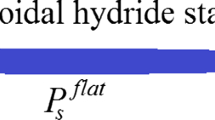Abstract
A multiphase microstructural system of two types of hydrides; f.c.c. δ and b.c.c.. ε hydride precipitates within a parent h.c.p. zircaloy-4 parent matrix were modelled by a crystalline dislocation-density and a finite-element (FE) method that is specialized for large inelastic strains and nonlinear behavior. The different crystalline structure of the hydrides, the parent matrix, and the orientation relationships between the different crystalline phases have been accounted for and modeled with a validated FE approach. The effects of radial hydride factors, hydride volume fraction, hydride morphology, and hydride orientation and distribution on overall behavior were investigated. The predictions provide an understanding of why a distribution of circumferential hydrides have higher strength and ductility than a distribution of radial hydrides. Furthermore, zircaloy δ (f.c.c.) hydride systems have less ductility and strength than the zircaloy ε (b.c.c.) systems.














Similar content being viewed by others
Change history
17 June 2021
A Correction to this paper has been published: https://doi.org/10.1007/s00466-021-02043-z
References
Northwood DO (1985) The development and applications of zirconium alloys. Mater Des 6(2):58–70
Hong S, Lee K, Kim K (2002) Effect of the circumferential hydrides on the deformation and fracture of zircaloy cladding tubes. J Nucl Mater 303(2–3):169–176
Motta AT et al (2019) Hydrogen in zirconium alloys: A review. J Nucl Mater 518:440–460
Zikry MA, Kao M (1996) Inelastic microstructural failure mechanisms in crystalline materials with high angle grain boundaries. J Mech Phys Solids 44(11):1765–1798
Shanthraj P, Zikry MA (2011) Dislocation density evolution and interactions in crystalline materials. Acta Mater 59(20):7695–7702
Chung H, Daum R, Hiller J, Billone M. Characteristics of hydride precipitation and reorientation in spent-fuel cladding. In: Zirconium in the nuclear industry: thirteenth international symposium, 100 barr harbor drive, PO box C700, West Conshohocken, PA, 19428–2959: ASTM International, 561–561–22
Ziaei S, Wu Q, Zikry MA (2018) Orientation relationships between coherent interfaces in hcp-fcc systems subjected to high strain-rate deformation and fracture modes. J Mater Res 30(15):2348–2359
Lee JM, Kim HA, Kook DH, Kim YS (2018) A study on the effects of hydrogen content and peak temperature on threshold stress for hydride reorientation in Zircaloy-4 cladding. J Nucl Mater 509:285–294
Colas KB, Motta AT, Daymond MR, Almer JD (2013) Effect of thermo-mechanical cycling on zirconium hydride reorientation studied in situ with synchrotron X-ray diffraction. J Nucl Mater 440(1–3):586–595
Motta AT, Couet A, Comstock RJ (2015) Corrosion of zirconium alloys used for nuclear fuel cladding. Annu Rev Mater Res 45(1):311–343
Puls MP (2012) The Effect of hydrogen and hydrides on the integrity of zirconium alloy compounds delayed hydride cracking. Springer, London
Long F, Kerr D, Domizzi G, Wang Q, Daymond MR (2017) Microstructure characterization of a hydride blister in Zircaloy-4 by EBSD and TEM. Acta Mater 129:450–461
Wang S, Giuliani F, Ben Britton T (2019) Microstructure and formation mechanisms of δ-hydrides in variable grain size Zircaloy-4 studied by electron backscatter diffraction. Acta Mater 169:76–87
Westlake DGG (1968) The habit planes of zirconium hydride in zirconium and zircaloy. J Nucl Mater 26(2):208–216
Liu Y, Peng Q, Zhao W, Jiang H (2008) Hydride precipitation by cathodic hydrogen charging method in zirconium alloys. Mater Chem Phys 110(1):56–60
Une K et al (2004) Crystallography of zirconium hydrides in recrystallized zircaloy-2 fuel cladding by electron backscatter diffraction. J Nucl Sci Technol 41(7):731–740
Burgers WG (1934) On the process of transition of the cubic-body-centered modification into the hexagonal-close-packed modification of zirconium. Physica 1(7–12):561–586
Zikry MAA (1994) An accurate and stable algorithm for high strain-rate finite strain plasticity. Comput Struct 50(3):337–350
Rico A, Martin-Rengel MA, Ruiz-Hervias J, Rodriguez J, Gomez-Sanchez FJ (2014) Nanoindentation measurements of the mechanical properties of zirconium matrix and hydrides in unirradiated pre-hydrided nuclear fuel cladding. J Nucl Mater 452(1–3):69–76
Kubo T, Kobayashi Y, Uchikoshi H (2013) Determination of fracture strength of δ-zirconium hydrides embedded in zirconium matrix at high temperatures. J Nucl Mater 435(1–3):222–230
Xu F, Holt RA, Daymond MR (2009) Modeling texture evolution during uni-axial deformation of Zircaloy-2. J Nucl Mater 394(1):9–19
Ziaei S, Zikry MA (2015) Modeling the effects of dislocation-density interaction, generation, and recovery on the behavior of h.c.p. materials. Metall Mater Trans A 46(10):4478–4490
Kim J-SS-S, Kim T-H-HH, Kook D-HH-H, Kim Y-SS-S (2015) Effects of hydride morphology on the embrittlement of Zircaloy-4 cladding. J Nucl Mater 456:235–245
Billone MCC, Burtseva TAA, Einziger REE (2013) Ductile-to-brittle transition temperature for high-burnup cladding alloys exposed to simulated drying-storage conditions. J Nucl Mater 433(1–3):431–448
Hong SII, Lee KWW (2005) Stress-induced reorientation of hydrides and mechanical properties of Zircaloy-4 cladding tubes. J Nucl Mater 340(2–3):203–208
Acknowldegement
Support from the Consortium for Advanced Simulation of Light (CASL) Water Reactors an Energy Innovation Hub for Modeling and Simulation of Nuclear Reactors, U.S. Department of Energy, Contract No. DE-AC05-00OR227 and the DOE NEUP Integrated Research Project IRP-17-13708 Development of a Mechanistic Hydride Behavior Model for Spent Fuel Cladding Storage and Transportation, is gratefully acknowledged.
Author information
Authors and Affiliations
Corresponding author
Ethics declarations
Conflict of interest
There are no conflict of interest and the research codes used in this study are available upon request.
Additional information
Publisher's Note
Springer Nature remains neutral with regard to jurisdictional claims in published maps and institutional affiliations.
The original version of this article was revised: The author names are incorrectly published. The correct names are updated in the article.
Rights and permissions
About this article
Cite this article
Mohamed, I., Zikry, M.A. Modeling of the microstructural behavior of hydrided zirconium alloys. Comput Mech 68, 567–578 (2021). https://doi.org/10.1007/s00466-020-01970-7
Received:
Accepted:
Published:
Issue Date:
DOI: https://doi.org/10.1007/s00466-020-01970-7




